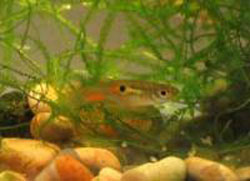Female guppies risk their lives to avoid too much male attention

Male and female guppies show a tendency to live in different types of habitats, known as sexual segregation.
Observing wild population of guppies in the rainforest of Trinidad, the researchers found that female guppies swim in habitats that contain few males – but many predators.
“Male guppies spend most of their time displaying to females. But if their courtship displays don’t impress the females, males will attempt to sneak mating with them when they aren’t looking,” says Croft.
Male guppies are brightly colored to attract female attention, while female guppies are a dull brown color. The researchers show that female guppies might use this color difference to their advantage, venturing into the deep water where predators lurk. The males’ bright coloring also attracts predators, making it too dangerous for them to follow.
“Understanding why and how [sexual segregation] occurs is essential if we are going to conserve and protect species and habitats,” explains Croft, who points out that fish are not the only species who display this social characteristic. “In many ecosystems, predators are the first to go extinct, and our work shows that this may have many, perhaps unexpected, effects. In this case, females may suffer more sexual harassment.”
Media Contact
More Information:
http://www.uchicago.eduAll latest news from the category: Life Sciences and Chemistry
Articles and reports from the Life Sciences and chemistry area deal with applied and basic research into modern biology, chemistry and human medicine.
Valuable information can be found on a range of life sciences fields including bacteriology, biochemistry, bionics, bioinformatics, biophysics, biotechnology, genetics, geobotany, human biology, marine biology, microbiology, molecular biology, cellular biology, zoology, bioinorganic chemistry, microchemistry and environmental chemistry.
Newest articles

Properties of new materials for microchips
… can now be measured well. Reseachers of Delft University of Technology demonstrated measuring performance properties of ultrathin silicon membranes. Making ever smaller and more powerful chips requires new ultrathin…

Floating solar’s potential
… to support sustainable development by addressing climate, water, and energy goals holistically. A new study published this week in Nature Energy raises the potential for floating solar photovoltaics (FPV)…

Skyrmions move at record speeds
… a step towards the computing of the future. An international research team led by scientists from the CNRS1 has discovered that the magnetic nanobubbles2 known as skyrmions can be…





















